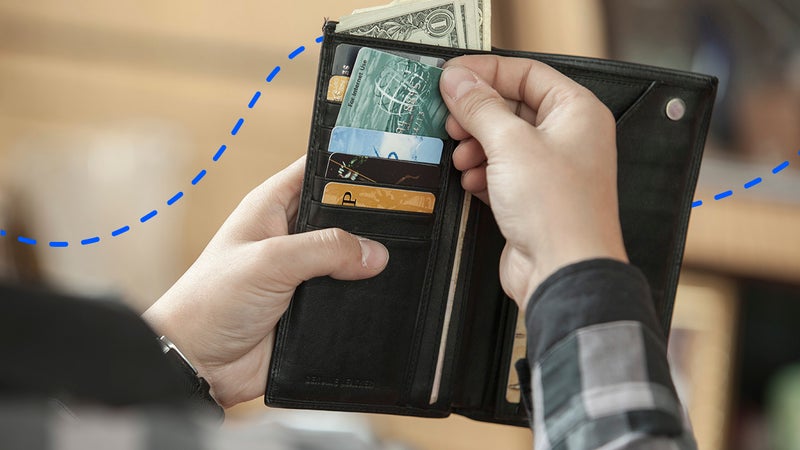How I built my credit with a credit card

The Bankrate promise
At Bankrate we strive to help you make smarter financial decisions. While we adhere to strict , this post may contain references to products from our partners. Here's an explanation for . The content on this page is accurate as of the posting date; however, some of the offers mentioned may have expired. Terms apply to the offers listed on this page. Any opinions, analyses, reviews or recommendations expressed in this article are those of the author’s alone, and have not been reviewed, approved or otherwise endorsed by any card issuer.
Key takeaways
- When used appropriately, credit cards can be powerful credit-building tools
- Depending on where you're starting from, a secured credit card can be a good first step to building strong credit.
- As you build a strong history with issuers, you may be able to move on to higher-level credit cards.
A good credit score is a privilege. I know it because my score is currently 784 (which is considered “very good” on the FICO scale), according to Experian. It has allowed me to add some of the best credit cards to my wallet, get a mortgage and pay off my car loan at a low rate — all pretty big credit milestones.
But it wasn’t always like that.
In 2018, my credit score was infuriatingly fair, hovering around 620. It seemed as though nothing I did could help it. But then I got a credit card.
A credit card isn’t just a convenient payment method with nice perks, rewards and fraud protection. It can also be an effective credit-building tool when you use it responsibly. That means paying the balance in full and on time and avoiding overspending. The latter can be a challenge. When you have a credit line, it’s all too easy to get carried away shopping and earning rewards.
I managed to avoid the pitfalls and used my cards successfully, but credit building wasn’t a quick process. Here’s how my journey went — and how you can use my experience to build credit with a card, too.
Picking the right card
Let’s go back to 2018 for a moment. I’m shopping for a credit card, and not yet the credit card nerd I’ve become today.
I know enough to realize I don’t have the most exciting options. At this point, I think I’d be happy with any card issuer that would have me. (I’m wrong. There are plenty of fish in the sea of bad credit card and fair credit card options.)
Fortunately, I come across Capital One, which promptly approves me for the Capital One Platinum Secured Credit Card.
Maybe the Capital One Secured isn’t the best secured credit card out there, since some secured cards offer better rewards these days, but it’s definitely not a bad card. Bad cards, unfortunately, are also abundant. Clueless as I am, I’m lucky I haven’t come across one of those. And Capital One is a top issuer, meaning it’s good to start a relationship with.
Having been burned in the past, I barely use my credit card. And if I do, I pay it off right away. As a result, in six months, I get a credit limit increase from $200 to $500.
Keeping credit utilization low
Cut to 2019. My career leads me to working in personal finance. It’s then that I start reading (and writing) countless articles about credit and learning from credit experts.
Now I know my cautious approach has been a good one. I learn about credit utilization ratios — how much balance you carry compared to your credit limit, expressed in a percentage. It turns out you shouldn’t use more than 30 percent of your credit line to keep your credit in good shape.
I do the math. If my credit limit is $500, I can carry a balance of up to $150 without hurting my credit.
That’s what I proceed to do.
Paying bills on time
Now it’s 2020. I’m still watching my credit like a hawk, and it’s been faring better. I’ve taken out a car loan, used Experian Boost to help my FICO score and continue learning more and more about credit cards.
I realize how many amazing credit cards there are, of all different types. My credit score isn’t high enough to qualify for them yet, so I keep my card balance low and religiously pay it off on time. I know now that a late payment is like a curse put on your credit reports for seven years, doing the evilest things to your scores, so I do my best to avoid being late.
Capital One sees my effort. The issuer triples my credit limit to $1,500, and my credit score loves it.
Upgrading to a better card
It’s still 2020. I decide it’s time to start being proactive. Capital One knows I’ve been a responsible and loyal customer, so I call the issuer to ask to graduate me to an unsecured card.
Capital One is happy to do so. Moreover, a customer service representative tells me I’m preapproved for the Capital One Quicksilver Cash Rewards Credit Card.
My first rewards credit card. I’m so ecstatic, it feels like Christmas morning.
Staying strategic with credit cards
It’s 2021 now. After some fluctuations, my credit score is finally good — meaning I’ve crossed the 670 threshold.
I now have five credit cards, including some I only dreamed about, like the American Express® Gold Card, the Chase Sapphire Preferred® Card and the Discover it® Cash Back. I’ve gone beyond just making on-time payments. I’m keeping my utilization low to raise my score. I’m collecting rewards in the top points programs and juggling multiple cards to earn higher rates on all of my different kinds of purchases.
I start to think about credit cards like doctor-prescribed treatment for financial health and well-being. If you follow the doctor’s orders and take care to use cards carefully, your credit and budget will be well. If not, side effects may include growing credit card debt and financial distress.
So, I keep following the prescription: Only apply for a credit card that you really need, keep your balances low and always pay on time.
My credit is healthy and so is my budget.
Changing my strategy when needed
It’s 2024, and back to the present. I still follow best card practices, but my card strategy evolves with my needs and spending patterns. I now have the Capital One Venture X Rewards Credit Card, a premium travel card. I’ve also canceled my Amex Gold and gotten the Capital One SavorOne Cash Rewards Credit Card. This way, I can pool the rewards I spend on flights within one ecosystem.
My credit score is very good or excellent, depending on which scoring model I’m checking. I still keep my old Capital One Quicksilver open since it’s the oldest account on my credit report — an important way to maximize your average credit line age, another credit scoring factor. Otherwise, I’m ready to change my card strategy whenever I need to. A high credit score opens the doors to most credit cards out there — and I’ve worked hard for mine. Now it’s time it works for me.
How you can implement these learnings in building and maintaining your credit
Before I became intentional about credit building, some steps I took were intuitive and some of my successes were pure luck. Nevertheless, you can use my takeaways and build your credit with a credit card, too. Here are some ways you can maximize your journey:
- Become an authorized user. If you don’t feel ready to own a credit card yet, consider talking to a trusted family member about becoming an authorized user on their account. If their card issuer reports authorized user activity to the three major credit bureaus, you’ll start building credit.
- Find the right credit card to become your credit-building tool. No matter where your credit is now, there are excellent products that can earn you rewards while improving your scores.
- Make a point to keep your balance low. It should be under 30 percent of your credit limit. Pay your bills on time and eventually, you’ll see your credit scores climb up.
- Track your credit to monitor your progress. In September of 2023, Equifax, Experian and TransUnion made their pandemic-era program of free weekly credit reports permanent. Make a habit of looking at your credit card reports every month or so to check for inaccuracies or signs of fraud — both of which can lower your credit score.
- Be proactive. While you’re not obligated to update your income information when issuers ask, doing so can lead to potential credit limit increases, which can lower your credit utilization ratio. Remember that you can also reach out to your issuer to ask for a credit limit increase if you haven’t gotten one in a while.
- Stay strategic about your credit cards. Each of your cards should have a purpose and fit your spending. When your current strategy doesn’t serve you anymore, evaluate it. It doesn’t always mean canceling a card. Instead, you can look into upgrading or downgrading it.
It may take a while to build your credit, but with these tips and some patience, you’ll see it grow soon enough.
The bottom line
There are plenty of benefits to knowing how to use a credit card to build credit. Never miss a payment, watch your card balances, be proactive and you’ll see your credit grow.
If you’re not sure where to start, use our CardMatch tool to pick a credit card that’s tailored to your credit and fits your needs. Checking the offers won’t impact your credit, and you’ll get card matches you have a good chance of being approved for.






